Jiaxu Zhang
DreamDance: Animating Character Art via Inpainting Stable Gaussian Worlds
May 30, 2025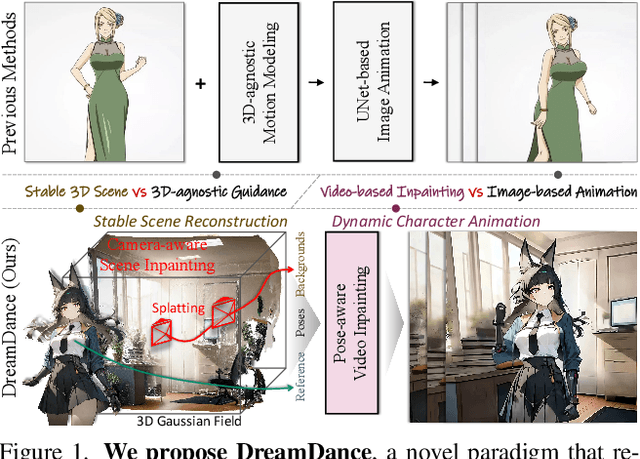

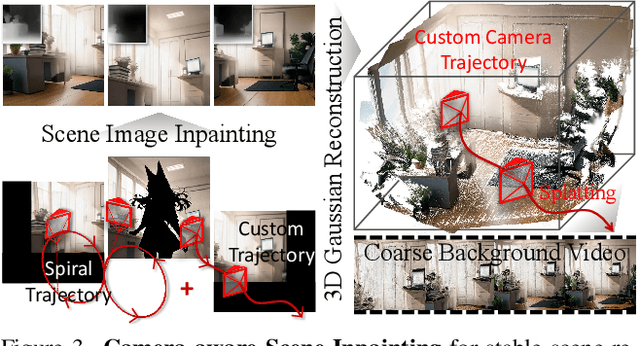
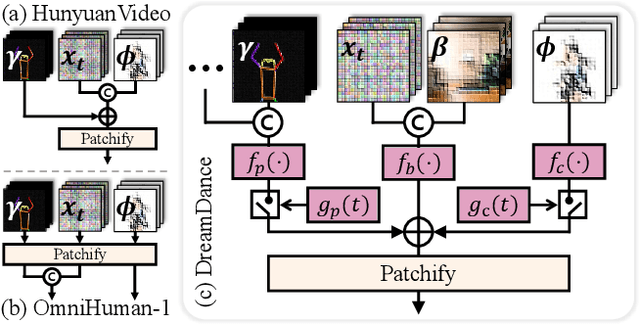
Abstract:This paper presents DreamDance, a novel character art animation framework capable of producing stable, consistent character and scene motion conditioned on precise camera trajectories. To achieve this, we re-formulate the animation task as two inpainting-based steps: Camera-aware Scene Inpainting and Pose-aware Video Inpainting. The first step leverages a pre-trained image inpainting model to generate multi-view scene images from the reference art and optimizes a stable large-scale Gaussian field, which enables coarse background video rendering with camera trajectories. However, the rendered video is rough and only conveys scene motion. To resolve this, the second step trains a pose-aware video inpainting model that injects the dynamic character into the scene video while enhancing background quality. Specifically, this model is a DiT-based video generation model with a gating strategy that adaptively integrates the character's appearance and pose information into the base background video. Through extensive experiments, we demonstrate the effectiveness and generalizability of DreamDance, producing high-quality and consistent character animations with remarkable camera dynamics.
EchoMask: Speech-Queried Attention-based Mask Modeling for Holistic Co-Speech Motion Generation
Apr 15, 2025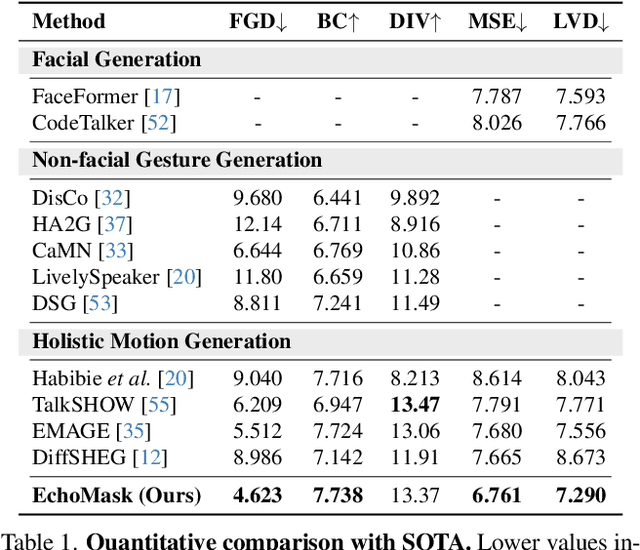
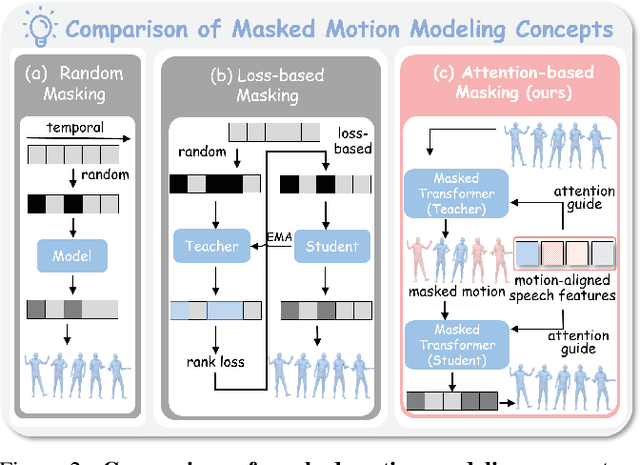
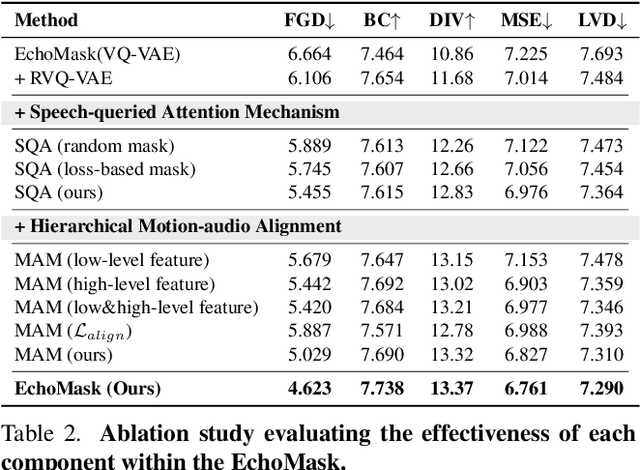
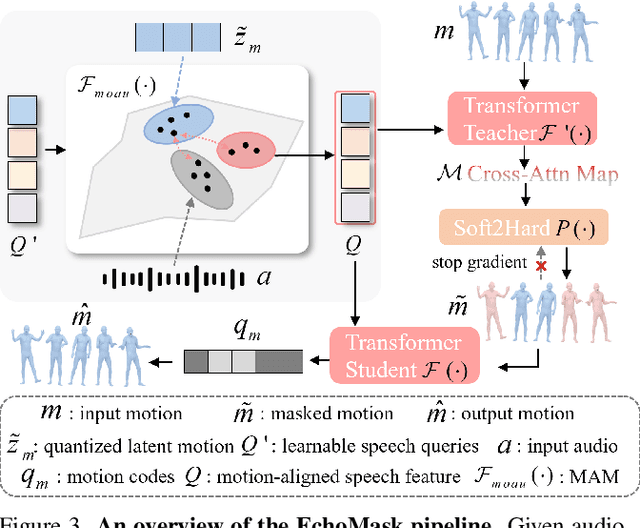
Abstract:Masked modeling framework has shown promise in co-speech motion generation. However, it struggles to identify semantically significant frames for effective motion masking. In this work, we propose a speech-queried attention-based mask modeling framework for co-speech motion generation. Our key insight is to leverage motion-aligned speech features to guide the masked motion modeling process, selectively masking rhythm-related and semantically expressive motion frames. Specifically, we first propose a motion-audio alignment module (MAM) to construct a latent motion-audio joint space. In this space, both low-level and high-level speech features are projected, enabling motion-aligned speech representation using learnable speech queries. Then, a speech-queried attention mechanism (SQA) is introduced to compute frame-level attention scores through interactions between motion keys and speech queries, guiding selective masking toward motion frames with high attention scores. Finally, the motion-aligned speech features are also injected into the generation network to facilitate co-speech motion generation. Qualitative and quantitative evaluations confirm that our method outperforms existing state-of-the-art approaches, successfully producing high-quality co-speech motion.
OmniSVG: A Unified Scalable Vector Graphics Generation Model
Apr 08, 2025Abstract:Scalable Vector Graphics (SVG) is an important image format widely adopted in graphic design because of their resolution independence and editability. The study of generating high-quality SVG has continuously drawn attention from both designers and researchers in the AIGC community. However, existing methods either produces unstructured outputs with huge computational cost or is limited to generating monochrome icons of over-simplified structures. To produce high-quality and complex SVG, we propose OmniSVG, a unified framework that leverages pre-trained Vision-Language Models (VLMs) for end-to-end multimodal SVG generation. By parameterizing SVG commands and coordinates into discrete tokens, OmniSVG decouples structural logic from low-level geometry for efficient training while maintaining the expressiveness of complex SVG structure. To further advance the development of SVG synthesis, we introduce MMSVG-2M, a multimodal dataset with two million richly annotated SVG assets, along with a standardized evaluation protocol for conditional SVG generation tasks. Extensive experiments show that OmniSVG outperforms existing methods and demonstrates its potential for integration into professional SVG design workflows.
SemTalk: Holistic Co-speech Motion Generation with Frame-level Semantic Emphasis
Dec 21, 2024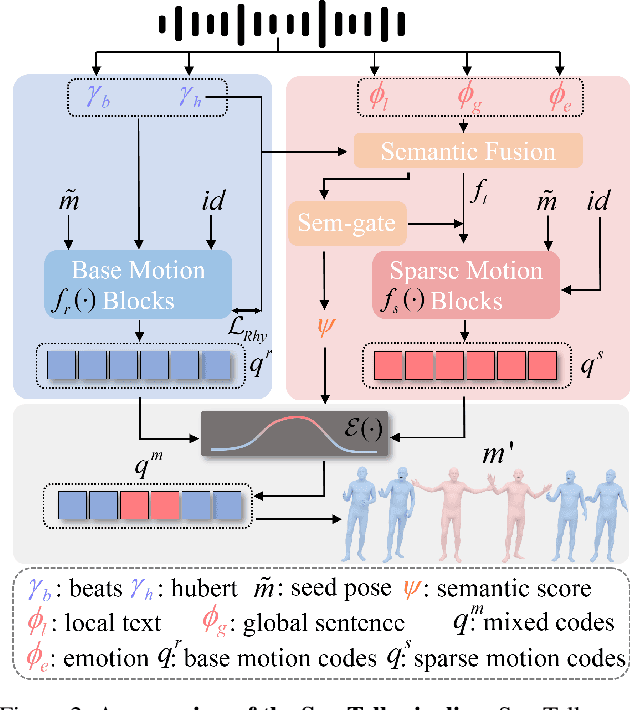
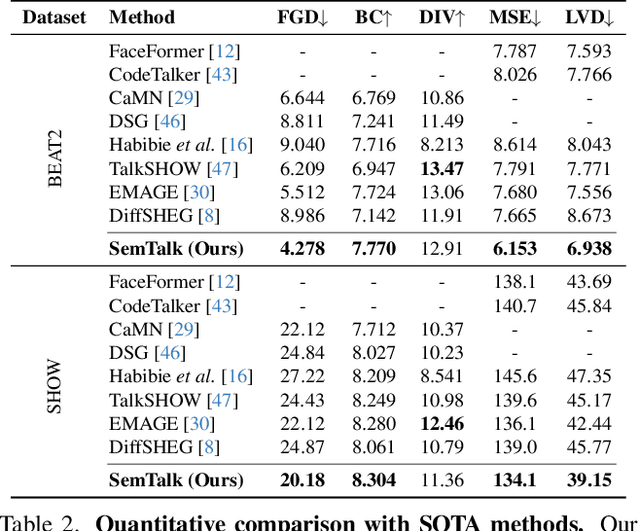
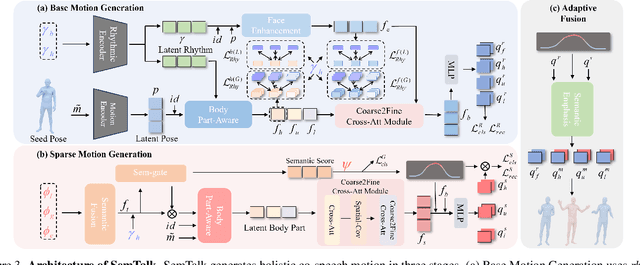
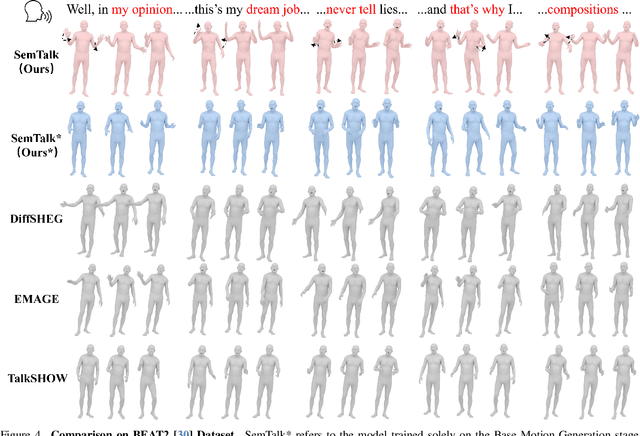
Abstract:A good co-speech motion generation cannot be achieved without a careful integration of common rhythmic motion and rare yet essential semantic motion. In this work, we propose SemTalk for holistic co-speech motion generation with frame-level semantic emphasis. Our key insight is to separately learn general motions and sparse motions, and then adaptively fuse them. In particular, rhythmic consistency learning is explored to establish rhythm-related base motion, ensuring a coherent foundation that synchronizes gestures with the speech rhythm. Subsequently, textit{semantic emphasis learning is designed to generate semantic-aware sparse motion, focusing on frame-level semantic cues. Finally, to integrate sparse motion into the base motion and generate semantic-emphasized co-speech gestures, we further leverage a learned semantic score for adaptive synthesis. Qualitative and quantitative comparisons on two public datasets demonstrate that our method outperforms the state-of-the-art, delivering high-quality co-speech motion with enhanced semantic richness over a stable base motion.
MikuDance: Animating Character Art with Mixed Motion Dynamics
Nov 14, 2024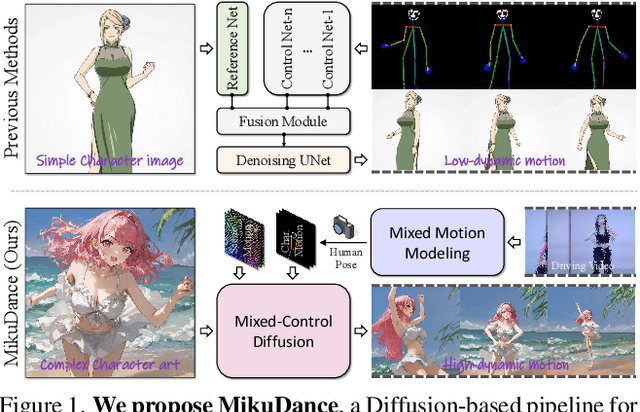
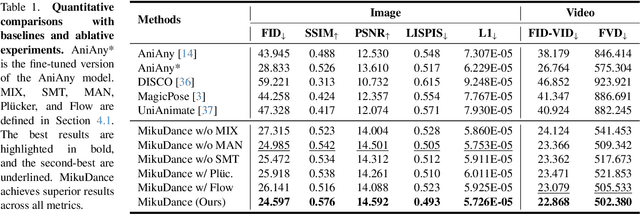


Abstract:We propose MikuDance, a diffusion-based pipeline incorporating mixed motion dynamics to animate stylized character art. MikuDance consists of two key techniques: Mixed Motion Modeling and Mixed-Control Diffusion, to address the challenges of high-dynamic motion and reference-guidance misalignment in character art animation. Specifically, a Scene Motion Tracking strategy is presented to explicitly model the dynamic camera in pixel-wise space, enabling unified character-scene motion modeling. Building on this, the Mixed-Control Diffusion implicitly aligns the scale and body shape of diverse characters with motion guidance, allowing flexible control of local character motion. Subsequently, a Motion-Adaptive Normalization module is incorporated to effectively inject global scene motion, paving the way for comprehensive character art animation. Through extensive experiments, we demonstrate the effectiveness and generalizability of MikuDance across various character art and motion guidance, consistently producing high-quality animations with remarkable motion dynamics.
Expressive Keypoints for Skeleton-based Action Recognition via Skeleton Transformation
Jun 26, 2024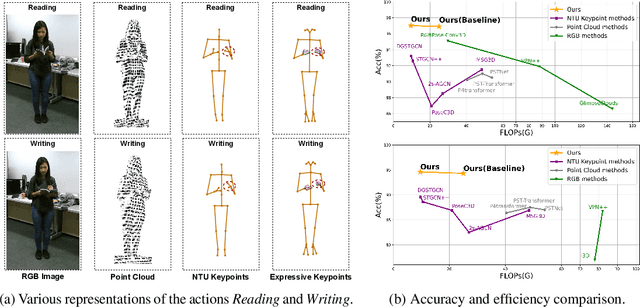

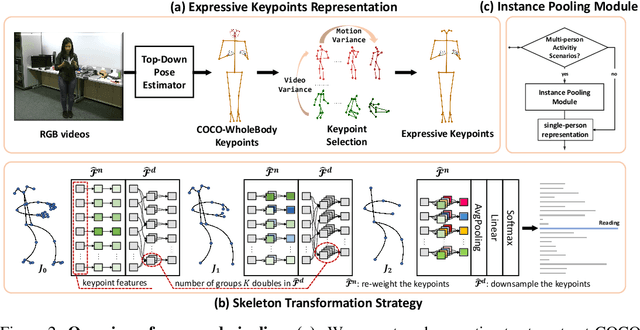

Abstract:In the realm of skeleton-based action recognition, the traditional methods which rely on coarse body keypoints fall short of capturing subtle human actions. In this work, we propose Expressive Keypoints that incorporates hand and foot details to form a fine-grained skeletal representation, improving the discriminative ability for existing models in discerning intricate actions. To efficiently model Expressive Keypoints, the Skeleton Transformation strategy is presented to gradually downsample the keypoints and prioritize prominent joints by allocating the importance weights. Additionally, a plug-and-play Instance Pooling module is exploited to extend our approach to multi-person scenarios without surging computation costs. Extensive experimental results over seven datasets present the superiority of our method compared to the state-of-the-art for skeleton-based human action recognition. Code is available at https://github.com/YijieYang23/SkeleT-GCN.
Generative Motion Stylization within Canonical Motion Space
Mar 18, 2024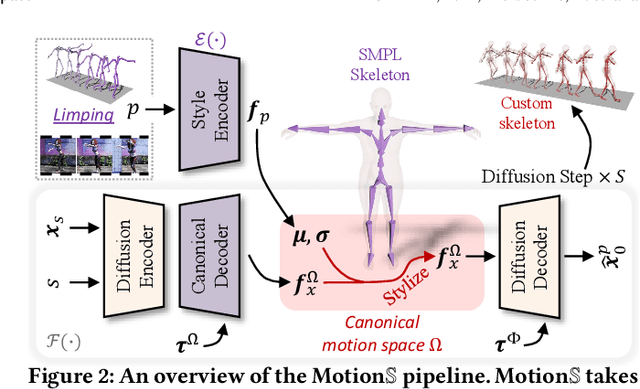
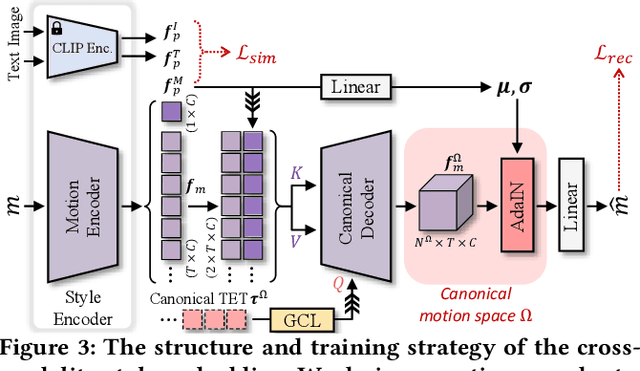

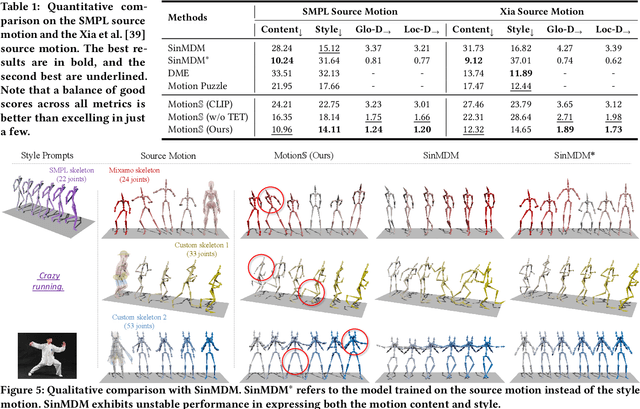
Abstract:Stylized motion breathes life into characters. However, the fixed skeleton structure and style representation hinder existing data-driven motion synthesis methods from generating stylized motion for various characters. In this work, we propose a generative motion stylization pipeline, named MotionS, for synthesizing diverse and stylized motion on cross-structure characters using cross-modality style prompts. Our key insight is to embed motion style into a cross-modality latent space and perceive the cross-structure skeleton topologies, allowing for motion stylization within a canonical motion space. Specifically, the large-scale Contrastive-Language-Image-Pre-training (CLIP) model is leveraged to construct the cross-modality latent space, enabling flexible style representation within this space. Additionally, two topology-encoded tokens are learned to capture the canonical and specific skeleton topologies, facilitating cross-structure topology shifting. Subsequently, the topology-shifted stylization diffusion is designed to generate motion content for the specific skeleton and stylize it in the shifted canonical motion space using multi-modality style descriptions. Through an extensive set of examples, we demonstrate the flexibility and generalizability of our pipeline across various characters and style descriptions. Qualitative and quantitative experiments underscore the superiority of our pipeline over state-of-the-art methods, consistently delivering high-quality stylized motion across a broad spectrum of skeletal structures.
TapMo: Shape-aware Motion Generation of Skeleton-free Characters
Oct 19, 2023Abstract:Previous motion generation methods are limited to the pre-rigged 3D human model, hindering their applications in the animation of various non-rigged characters. In this work, we present TapMo, a Text-driven Animation Pipeline for synthesizing Motion in a broad spectrum of skeleton-free 3D characters. The pivotal innovation in TapMo is its use of shape deformation-aware features as a condition to guide the diffusion model, thereby enabling the generation of mesh-specific motions for various characters. Specifically, TapMo comprises two main components - Mesh Handle Predictor and Shape-aware Diffusion Module. Mesh Handle Predictor predicts the skinning weights and clusters mesh vertices into adaptive handles for deformation control, which eliminates the need for traditional skeletal rigging. Shape-aware Motion Diffusion synthesizes motion with mesh-specific adaptations. This module employs text-guided motions and mesh features extracted during the first stage, preserving the geometric integrity of the animations by accounting for the character's shape and deformation. Trained in a weakly-supervised manner, TapMo can accommodate a multitude of non-human meshes, both with and without associated text motions. We demonstrate the effectiveness and generalizability of TapMo through rigorous qualitative and quantitative experiments. Our results reveal that TapMo consistently outperforms existing auto-animation methods, delivering superior-quality animations for both seen or unseen heterogeneous 3D characters.
Skinned Motion Retargeting with Residual Perception of Motion Semantics & Geometry
Mar 15, 2023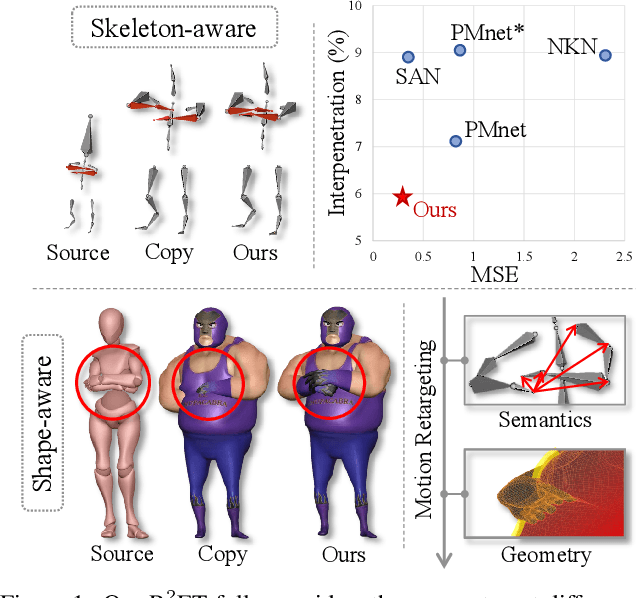
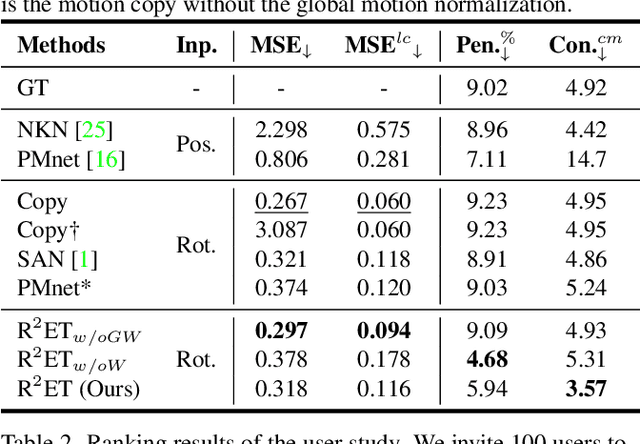

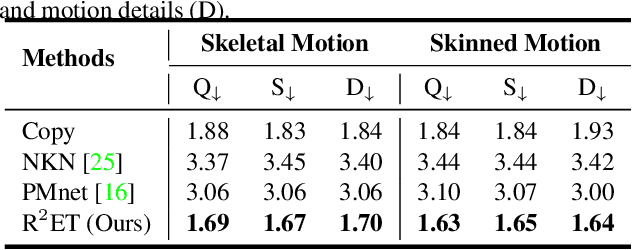
Abstract:A good motion retargeting cannot be reached without reasonable consideration of source-target differences on both the skeleton and shape geometry levels. In this work, we propose a novel Residual RETargeting network (R2ET) structure, which relies on two neural modification modules, to adjust the source motions to fit the target skeletons and shapes progressively. In particular, a skeleton-aware module is introduced to preserve the source motion semantics. A shape-aware module is designed to perceive the geometries of target characters to reduce interpenetration and contact-missing. Driven by our explored distance-based losses that explicitly model the motion semantics and geometry, these two modules can learn residual motion modifications on the source motion to generate plausible retargeted motion in a single inference without post-processing. To balance these two modifications, we further present a balancing gate to conduct linear interpolation between them. Extensive experiments on the public dataset Mixamo demonstrate that our R2ET achieves the state-of-the-art performance, and provides a good balance between the preservation of motion semantics as well as the attenuation of interpenetration and contact-missing. Code is available at https://github.com/Kebii/R2ET.
Joint-bone Fusion Graph Convolutional Network for Semi-supervised Skeleton Action Recognition
Feb 08, 2022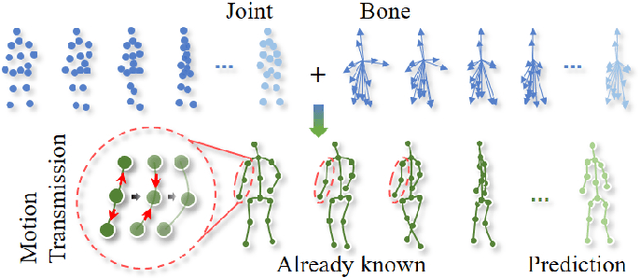

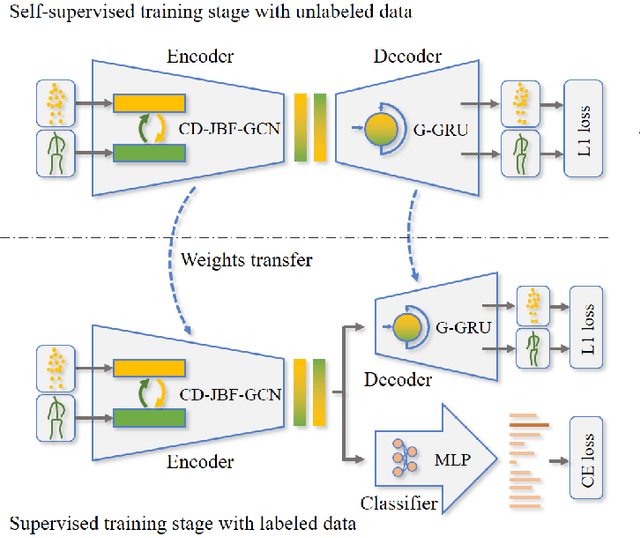
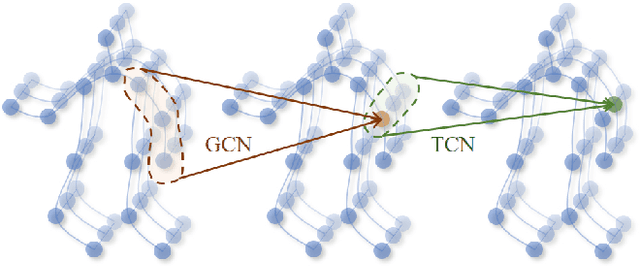
Abstract:In recent years, graph convolutional networks (GCNs) play an increasingly critical role in skeleton-based human action recognition. However, most GCN-based methods still have two main limitations: 1) They only consider the motion information of the joints or process the joints and bones separately, which are unable to fully explore the latent functional correlation between joints and bones for action recognition. 2) Most of these works are performed in the supervised learning way, which heavily relies on massive labeled training data. To address these issues, we propose a semi-supervised skeleton-based action recognition method which has been rarely exploited before. We design a novel correlation-driven joint-bone fusion graph convolutional network (CD-JBF-GCN) as an encoder and use a pose prediction head as a decoder to achieve semi-supervised learning. Specifically, the CD-JBF-GC can explore the motion transmission between the joint stream and the bone stream, so that promoting both streams to learn more discriminative feature representations. The pose prediction based auto-encoder in the self-supervised training stage allows the network to learn motion representation from unlabeled data, which is essential for action recognition. Extensive experiments on two popular datasets, i.e. NTU-RGB+D and Kinetics-Skeleton, demonstrate that our model achieves the state-of-the-art performance for semi-supervised skeleton-based action recognition and is also useful for fully-supervised methods.
 Add to Chrome
Add to Chrome Add to Firefox
Add to Firefox Add to Edge
Add to Edge